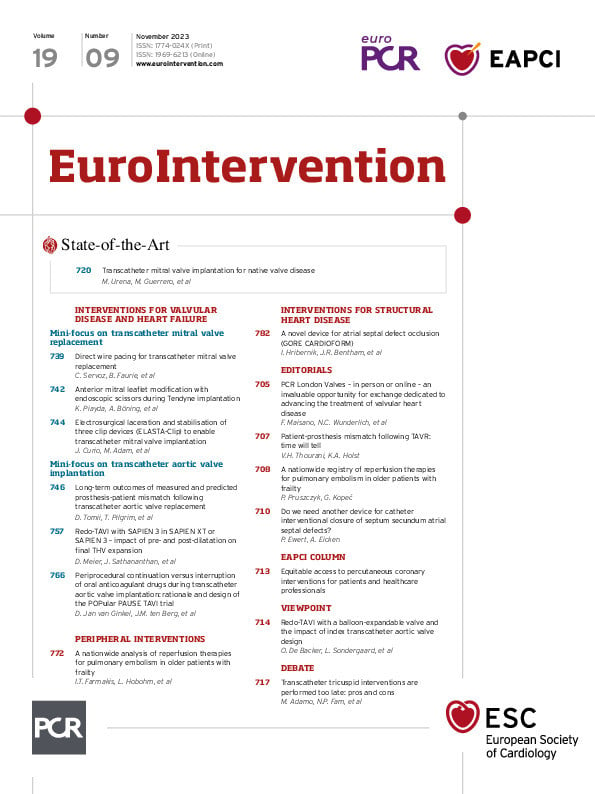In this issue of EuroIntervention, the team from the University of Bern in Switzerland present their assessment of patient-prosthesis mismatch (PPM) following transcatheter aortic valve replacement (TAVR) at their centre through a prospectively maintained registry of 2,463 patients1. Tomii and colleagues explored three distinct assessments of PPM in the study population: measured PPM on the discharge echocardiogram, predicted PPM by the effective orifice area of the implanted TAVR prosthesis, and predicted PPM by preprocedural cross-sectional imaging. As our understanding of PPM continues to grow, this report offers real-world insight into the prevalence and implications of PPM.
The authors describe the prevalence of PPM in the study population undergoing TAVR, which was consistent with recent publications23. The prevalence of measured PPM, based on echocardiographic parameters, was higher than that of PPM predicted by either the effective orifice area (EOA) of the implanted prosthesis or preprocedural cross-sectional imaging. Our understanding of the implications of PPM as quantified via various metrics is not clear and is a topic of growing research in the cardiovascular field.
Patients in this study underwent TAVR between 2007 and 2022, and the study benefitted from structured follow-up via the nationwide Swiss TAVI Registry. Albeit, the median follow-up was only 14 months (interquartile range ~1-4.7 years), and the largest limitation of this analysis is the unknown number of patients at risk at timepoints beyond 5 years. Therefore, it is difficult to translate the findings at the median of 14 months of follow-up to the impact of PPM on long-term outcomes at 10 years.
The heterogeneous patient population adds the potential for unaccounted-for confounding variables. Of the study population, 63% had balloon-expandable TAVR and 37% had self-expanding TAVR; additionally, 5.2% had valve-in-valve procedures. Other characteristics of the study population were not readily available; these include ejection fraction, incidence of heart block, prevalence of bicuspid aortic valve pathology, and year of TAVR implant. These important clinical variables were not included in the adjustment modelling but may have a significant impact on outcomes.
The authors performed adjusted modelling for the primary study outcomes − including all-cause mortality, cardiovascular death, structural valve deterioration, and repeat aortic valve intervention − by both measured and predicted PPM. The multivariable modelling controlled for patient age, sex, and Society of Thoracic Surgery Predicted Risk of Mortality (STS-PROM) score. The study was not powered to adjust for other variables that may contribute to long-term outcomes, specifically, valve type, ejection fraction, or heart block. Through adjusted modelling, the authors concluded that there was no difference in outcomes based on measured or predicted PPM at 10 years. However, they do report that patients with moderate predicted PPM based on the EOA of the prosthesis had better adjusted survival than those with no PPM. While this finding is statistically significant, it is inconsistent with the established understanding of PPM and is likely a reflection of either an unaccounted-for confounder or the small sample size.
The authors should be congratulated on an important submission on a complex disease process. Their study is a real-world analysis of the prevalence of measured and predicted PPM following TAVR, although this was limited by the duration of follow-up and the ability to correct for numerous potential confounders. This paper is an important contribution as the cardiovascular community continues to develop its understanding of both how to assess PPM and the corresponding implications. The results should be critically assessed, and we look forward to further study and follow-up of this study population.
Conflict of interest statement
V.H. Thourani has received support from Abbott Vascular, Artivion, Edwards Lifesciences, Medtronic, Boston Scientific, JenaValve, and Trisol. K.A. Holst has no conflicts of interest to declare.




